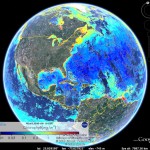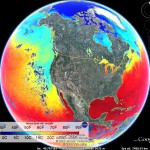August 30, 2010 12:53 PM
by Kurt
Read more of this story at Slashdot.
Over on BoingBoing Maggie Koerth-Baker interviews Jordan Needham about the underwater fort he and his family built at the bottom of a lake.
The dome is vinyl from the local fabric store. We switched from plastic because the plastic was kind of "cloudy" and the vinyl is optically clear. When The Bubble Room is not in use we take the net and vinyl with us and it is just a metal ring sitting on the lake bed. It takes one person about 15 minutes to attach the net and vinyl and fill it with air. All the materials except for the vinyl where free!
Inside a Nevada family's underwater fort
Last week we had just received the UD-134 glider (aka the "Blue Hen") from two tours of duty in the Gulf of Mexico in collaboration with IOOS and Rutgers University for the Deepwater Horizon Oil Spill Response project. To prepare for an upcoming Antarctic mission, we needed to get some work done on UD-134 at the source – Teledyne Webb Research in Massachusetts. Since we were only five hours south of Webb at the time, I loaded the Zune HD (with purely educational podcasts of course – in this case Security Now) and it was road-trip time for me and two of the students from the ORB lab.
The students who went with were really excited to get to learn from the masters while we tore down UD-134 at Rutgers. (For those new to gliders, Rutgers is the undisputed kings of the glider realm, they've been flying them since, like forever). One of the students who came with was a summer intern who was charged with learning how to pilot the Glider over the summer. Because of the last-minute deployment of UD-134 in the Gulf, he had lots of pilotting time on a simulator, but not so much hands-on with real Gliders. The other student was a new grad student who would be responsible for ingesting and processing glider data, so she was looking forward to the trip as well. When we decided at the last minute to head up to Webb Research to deliver the components, the intern said he "felt like Willie Wonka with the winning ticket to tour the chocolate factory". He was definitely not disappointed as Peter Collins met us at the doors of Webb and gave the students and I the grand tour.
Peter Collins (aka "Texas Pete" for this post) donned his cowboy hard hat and headed to the ballast tank with me and a couple of our students last week to do a quick talk for Ocean Bytes. Pete gave a quick introduction to the Slocum Electric Glider - an Autonomous Underwater Vehicle (AUV) or Underwater Glider that is made by Teledyne Webb Research. Take note that the glider that Pete has in front of him as it is a tad different from most in that it has two science bays (there is usually only one). This one is being fitted with a Photosynthetically Active Radiation (PAR) sensor and a FIRe sensor (remember Lauren's video?) from Satlantic. I'll hand you to Peter now so he can discuss what a glider is for and how it works…
In addition to the lineup of first generation gliders, we were introduced to the second generation gliders that are just now being manufactured – also called the "G2″ gliders. I'll try to cover everything that we learned about the G2 systems in a future post.
Thanks again Peter for the awesome hospitality and for taking such great care of us!
http://www.youtube.com/watch?v=eMrOFuSZAj4&feature=youtube_gdata_player
Art Trembanis
CSHEL
University of Delaware
www.geology.udel.edu/cshel
Art Trembanis
CSHEL
University of Delaware
www.geology.udel.edu/cshel
Art Trembanis
CSHEL
University of Delaware
www.geology.udel.edu/cshel
Art Trembanis
CSHEL
University of Delaware
www.geology.udel.edu/cshel


As a new grad student in the ORB (Ocean exploration, Remote Sensing, and Biogeography) lab at the University of Delaware under Dr. Matthew Oliver, I (along with my cohort Danielle Haulsee) were tasked with learning to write code in R. R is a language that enables statistical computing and making graphical displays. To some of you this may sound basic, but having no prior programming experience it was a little overwhelming at times. After getting the basics down, we then started pulling sea surface temperature and chlorophyll data from NASA's Goddard Space Flight Center (GSFC) MODIS Aqua satellite. This isn't just any temperature and chlorophyll data either, it's real-time and updated everyday! From this we were able to create maps on Google Earth, which is a great platform for viewing and interacting with multiple data layers on a global scale. This allows us to easily distribute NASA's data for ocean planning. These overlays along with others were also able to assist in planning Slocum Glider missions in areas surrounding the Gulf oil spill.
In our Google Earth maps, we created 1, 3, and 8 day averages that reflect the current conditions in the ocean. Each day our code downloads the lastest satellite data that has been updated on NASA's website and then it is averaged along with the previous days to create an average. The 1 day average maps are patchy due to the fact that the satellites can not see through the clouds. Therefore, the 8 day averages make for a more complete and accurate picture. For higher resolution images, we created smaller maps of just California, the East Coast and even Antarctica! These locations correspond to areas that we conduct further research in. Google Earth was interested in our overlays so check out the Google Earth Gallery for sea surface temperature and chlorophyll concentrations near you!
Art Trembanis
CSHEL
University of Delaware
www.geology.udel.edu/cshel
 The Lost Knowledge column explores the possible technologies of the future in the forgotten ideas of the past (and those slightly forgotten or just off to the side). We look at retro-tech, "lost" technology, and the make-do, improvised "street tech" of village artisans and tradespeople from around the globe. "Lost Knowledge" was also the theme of MAKE Volume 17
The Lost Knowledge column explores the possible technologies of the future in the forgotten ideas of the past (and those slightly forgotten or just off to the side). We look at retro-tech, "lost" technology, and the make-do, improvised "street tech" of village artisans and tradespeople from around the globe. "Lost Knowledge" was also the theme of MAKE Volume 17
One of my favorite sites for finding ideas for the "Lost Knowledge" column, Low-Tech Magazine, has a piece (first in a series?) called "Lost Knowledge: ropes and knots." Hey, why not? We've been... "borrowing" from them... In fact, I'd been planning on doing a column on knot tying, and again, they've done most of the work for me! They actually have two fairly in-depth features, the "Ropes and knots" piece and "How to tie the world together: online knotting reference books." Here are some excerpts from these pieces, followed by some additional resources, and previous knotty content from MAKE.

From "Lost Knowledge: Ropes and knots:"
Few realize the importance that knots and cords have played in human history. It is remarkable that they are not even mentioned in otherwise great books on the history of technology. Yet, it is hard to find any important technology developed over the last 250,000 years that did not, in some way, make use of ropes and knots. Starting in prehistoric times, they were used for hunting, pulling, fastening, attaching, carrying, lifting and climbing.
The hardware: ropesRead the Full Story » | More on MAKE » | Comments » | Read more articles in Retro | Digg this!
From fibers to rope In rope making, four basic steps are identified: preparing the fibre, spinning the fibres together to form yarns, twisting the yarns in bunches to form strands, and winding the strands in rope.At each stage the twisting is performed in the opposite direction from the previous stage, in order to overcome the natural tendency for each yarn, strand or rope to unravel. Most ropes consist of three twisted strands (called a Hawser laid rope).
Art Trembanis
CSHEL
University of Delaware
www.geology.udel.edu/cshel
Art Trembanis
CSHEL
University of Delaware
www.geology.udel.edu/cshel
Read more of this story at Slashdot.
Art Trembanis
CSHEL
University of Delaware
www.geology.udel.edu/cshel
Art Trembanis
CSHEL
University of Delaware
www.geology.udel.edu/cshel